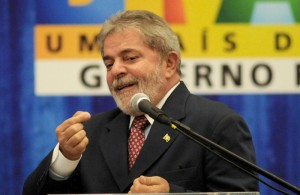By Richard Basas (Latin America blog)
 Last month I was fortunate to have the opportunity to participate and ask questions of Brazil’s Minister of Planning, Budget and Management, Mr. Paulo Bernardo. The discussion was an overview for foreign investors, economic experts and journalists on the second phase of Brazil’s national Growth Acceleration Program (PAC 2), which is the second phase of Brazil’s massive investment into infrastructure, public works, transportation and energy. In addition to the massive amounts of investment going into Brazil under PAC 2, there have been some socially focused initiatives such as investments in housing and drainage to address Brazil’s plague of floods and turn Brazil’s favelas into a more habitable and functional environment. Over the 2011-2014 period, the PAC 2 will involve approximately USD$526 billion in strategic funding, and with Brazil’s investment initiatives, FIFA and Olympic preparations and Brazil’s massive energy and infrastructure sectors, local and foreign investment opportunities hope to build Brazil into its place as the next mega-economy with the roads and infrastructure to avoid growth bottlenecks and keep growth exponential.
Last month I was fortunate to have the opportunity to participate and ask questions of Brazil’s Minister of Planning, Budget and Management, Mr. Paulo Bernardo. The discussion was an overview for foreign investors, economic experts and journalists on the second phase of Brazil’s national Growth Acceleration Program (PAC 2), which is the second phase of Brazil’s massive investment into infrastructure, public works, transportation and energy. In addition to the massive amounts of investment going into Brazil under PAC 2, there have been some socially focused initiatives such as investments in housing and drainage to address Brazil’s plague of floods and turn Brazil’s favelas into a more habitable and functional environment. Over the 2011-2014 period, the PAC 2 will involve approximately USD$526 billion in strategic funding, and with Brazil’s investment initiatives, FIFA and Olympic preparations and Brazil’s massive energy and infrastructure sectors, local and foreign investment opportunities hope to build Brazil into its place as the next mega-economy with the roads and infrastructure to avoid growth bottlenecks and keep growth exponential.
There are many debates over the application of PAC 2 surrounding funding and corruption, poverty, the politics of the end of Lula’s Presidency, and as expected, the focus and nature of the investments themselves. Concerns in the discussion over missing funds and corruption were addressed as a matter for the Federal Police and the Justice Department which were said to be working in concert with the Federal Government’s investment initiatives. Concerns over flooding, especially in Brazil’s poorer areas which affected many shanty towns last month were also addressed as a part of why the PAC 2 is needed, specifically in poorer areas. While not mentioned in the discussion, there have been quite a lot of debate on the political motivations for applying the PAC 2 a few months before the election of Brazil’s new President as Lula closes this latest chapter in his political career and steps down as Brazil’s President. In the end, the discussion centred around how foreign investors can bring funding and apply for bids in bringing foreign investment and know how into Brazil over the next four years. With USD$526 billion in investment going into polishing up Brazil and preparing it for massive growth in the near future, investors will find it hard to ignore the possible opportunities in growing Brazil with a lot of opportunity for profit to be created for those interested in joining in the financial risk and opportunities of the latest BRIC to bloom. Compared to the US Bailout, which is over USD$700 billion, it is easy to see how USD$526 billion is a massive opportunity for foreign firms to invest in Brazil.
Questions asked by myself surrounded those of how foreign investment and transfer of technology agreements would be treated in projects under the PAC 2. While projects would differ in size, quantity and quality of investment, Mr. Bernardo confirmed that agreements within the PAC 2 and with the Brazilian Government would seek to bring not only investment, but also bring know-how and ensure that technology transfer in the PAC 2 would allow for advancements in the local Brazilian economy after 2014 through contractual agreements between Brazil and foreign investors. Often BRIC economies seek investment as well as know-how in order to advance quicker economically and build up R+D to create a momentum of economic progress over an extended period of time. It is very likely that the boost of growth in Brazil and PAC 2 will receive a lot more attention as one of the largest global investment projects and take some attention away from China’s and India’s growth as investors follow the golden rule and diversify past the US, Europe and other BRIC nations.
